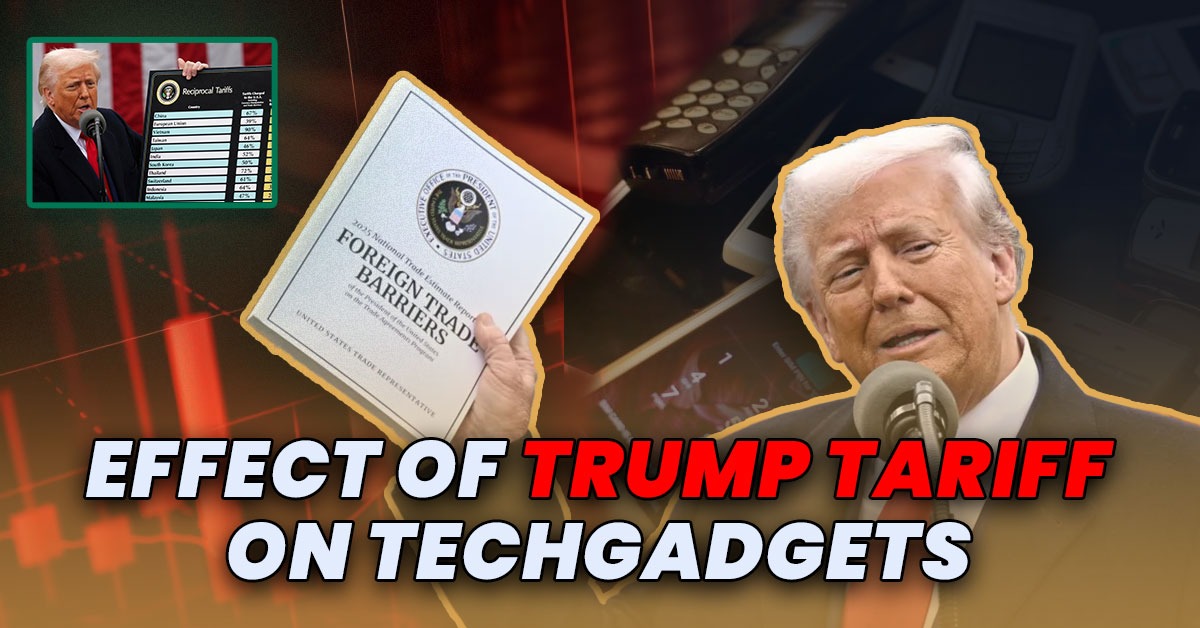
Effect of Trump tariff on techgadgets
Imposing tariffs on hundreds of billions of dollars’ worth of Chinese products in 2018, the Trump administration set off a worldwide economic change. Under Section 301 of the Trade Act of 1974, these tariffs sought to address what the administration called unjustified trade policies China was pursuing. Although these activities were wide and complex, the technology sector was among the most sensitive ones impacted. From smartphones and computers to smart home products and accessories, tech items found themselves front and center in this economic storm. The tariffs affected prices, innovation, and consumer behavior in the worldwide tech industry as well as disturbed supply lines.
Price hikes
One of the most immediate consequences of the Trump tariffs was the rise in prices for a number of well-known tech products. Businesses that obtained parts or whole goods from China incurred extra costs of up to 25%, which were frequently passed down to customers. Items including laptops, tablets, drones, smartwatches, and even some accessories like phone cases or chargers grew in price. For example, analysts at the time forecasted a potential $120 increase in the average cost of a laptop. Particularly during peak shopping times like Black Friday and back to school events, this inflation weight landed on regular customers and had a major influence on buying decisions.
Supply chain disruptions
The tariffs made technology firms rethink their world supply chains. To lessen reliance on China, major companies including Apple, HP, and Dell began investigating possible relocation of their production facilities to nations such as Vietnam, India, and Mexico. Still, changing production is neither a quick nor inexpensive process. It entails guaranteeing quality control, managing logistics, developing infrastructure, and obtaining labor. These changes in the supply chain impacted the pricing and availability of technology products in several international marketplaces by causing temporary inefficiencies and delays. While some businesses found it possible to diversify successfully, others found it difficult to keep delivery schedules and product consistency.
Product redesign
To avoid tariff costs, some tech companies resorted to redesigning their products or reclassifying them under different customs codes that were not subject to the new tariffs. This strategy, while legally complex, allowed manufacturers to avoid certain fees. For example, a smart speaker that was previously classified as an audio product might be redesigned slightly to qualify as a data processing device, which may have a lower or no tariff. This approach demonstrates the intricate relationship between trade policy and product engineering, where even minor legal definitions can impact business strategy and innovation.
What was the impact on small tech companies?
Small firms and startups suffered more whereas major tech corporations had the financial and logistical means to adjust to tariffs. Particularly in the prototyping and early production phases, many new technology businesses depend on Chinese suppliers for affordable manufacturing. Tariffs extra expense usually resulted in either reduced profit margins or the inability to price products competitively. Some startups went out of business entirely, postponed product launches, or scrapped initiatives. This stifled creativity and exacerbated the already difficult environment for entrepreneurs in tech startups during this period.
Decline in electronic sales
The cumulative effect of higher prices and reduced supply was a noticeable dip in consumer electronics sales, particularly in the US market. Retailers reported lower demand for some categories of gadgets, and companies experienced slower year over year growth. In an industry where innovation and constant upgrading are the norm, even a slight slowdown in consumer spending can have ripple effects across R&D, marketing, and future product cycles. Additionally, international competitors not affected by the tariffs gained an edge, as consumers sought more affordable alternatives from non US or non-Chinese brands.
Long term shift
Beyond their direct economic impact, the Trump tariffs started a long term rethinking of world technology partnerships. Companies and nations started to vary not only their supply chains but also their technological alliances. Including large investments in semiconductor manufacturing and artificial intelligence technologies, China quickened its efforts to create self sufficient tech ecosystems. US at once companies tried to work more closely with EU and Southeast Asian countries. These changes are creating a more dispersed but resilient worldwide technology scene where national interests increasingly affect the movement of ideas and products.
Trade policy
The unpredictability the Trump tariff plan introduced in the corporate world was one of its key drawbacks. At times, tariffs were applied with little notice, suddenly amended, or suspended erratically. For technology firms with long product development and supply cycles, this volatility complicates planning severely. Rising complexity in forecasting expenses, retail pricing, and inventory management some businesses started stockpiling inventory before tariff deadlines, causing phony supply variations. Still others scaled back innovation because of the unpredictable cost terrain.
Alternative manufacturing hubs
The rise of new manufacturing centres beyond China, made possible by the tariffs imposed during the Trump era, is among the most important long term effects. Tech manufacturing found appealing possibilities in nations including Vietnam, India and even sections of Eastern Europe. Many international companies fundamentally invested in infrastructure and labor training in these areas. For example, Apple began experimental iPhone manufacturing in India and Vietnam, something that would have been unheard of a few years ago. This difference boosted firms resilience against next trade interruptions and lowered their exposure to geopolitical concerns. Still, increasing capacity in these more recent centers is still a work in progress, and not all goods can be easily switched because of technology and logistics constraints.
What were the effects on chip prices?
Aside from popular consumer electronic products, the tariffs also had an effect on the availability and pricing of vital technology like semiconductors, circuit boards and displays. Most of these components were either manufactured in China or made of Chinese materials, so tariffs caused an increase in input costs across the whole spectrum. The makers of chips had to find the best way to deal with significantly higher costs, an unsteady demand, and making the supply chain efficient. In the worst cases, this was the cause of the resulting higher contract prices for OEMs (Original Equipment Manufacturers), who then increased prices for the end consumer products. The early stages of the pandemic and the types of components disrupted by tariffs had set the stage for the more pronounced chip shortage that ensued during and after the covid-19 health crisis.
Conclusion
The Trump tariffs were initially designed to adjust the trade balance with China, but besides that, they affected the wholeness of tech gadget industry greatly. Prices were raised, supply chains were renovated, and habits of innovations were changed. Even though certain portions of the tariffs were reformed or withdrawn during the Biden administration, the resultant strategic changes were not totally canceled. The reaction in the global tech sector is that now they see the risks of their systems and are building stronger, less risky, and more flexible operating models. Through the whole process, the Trump tariffs were at once the source of the revolution and its motor that stayed on, thus finally the manner of tech gadgets manufacturing, their prices, and the consumers’ perception everywhere in the world have become different permanently.
